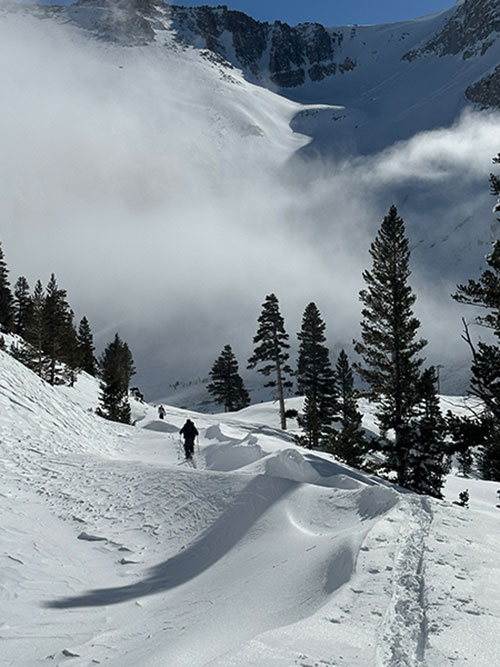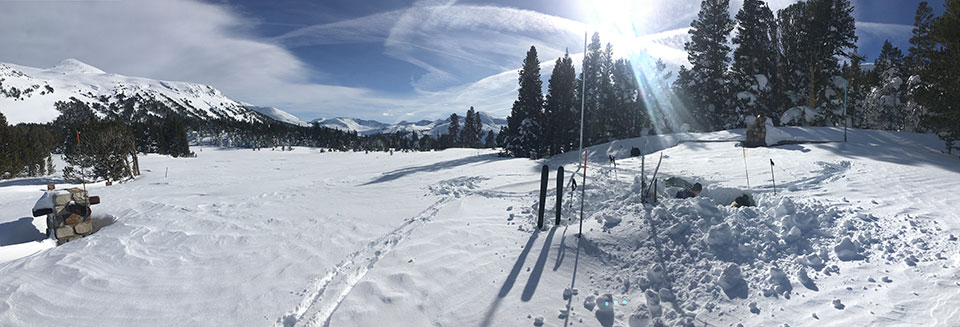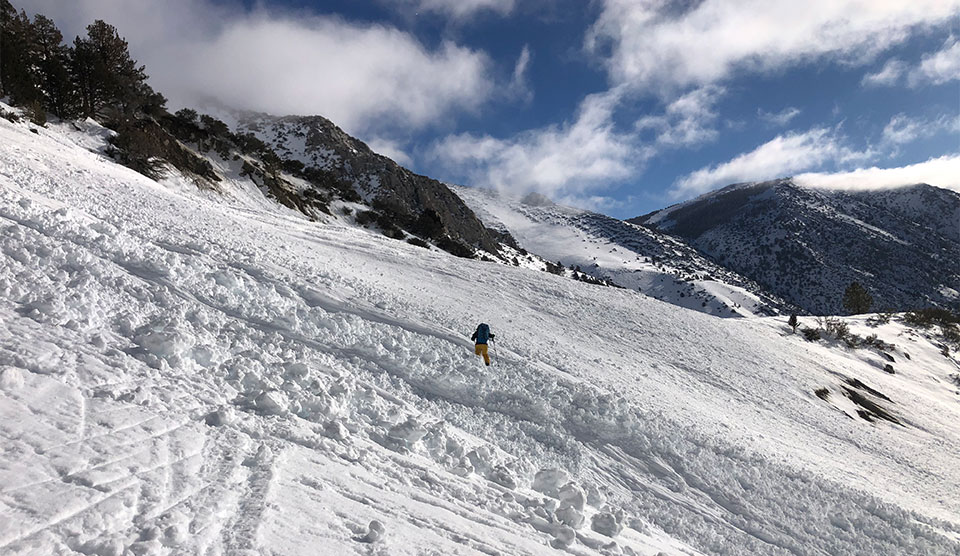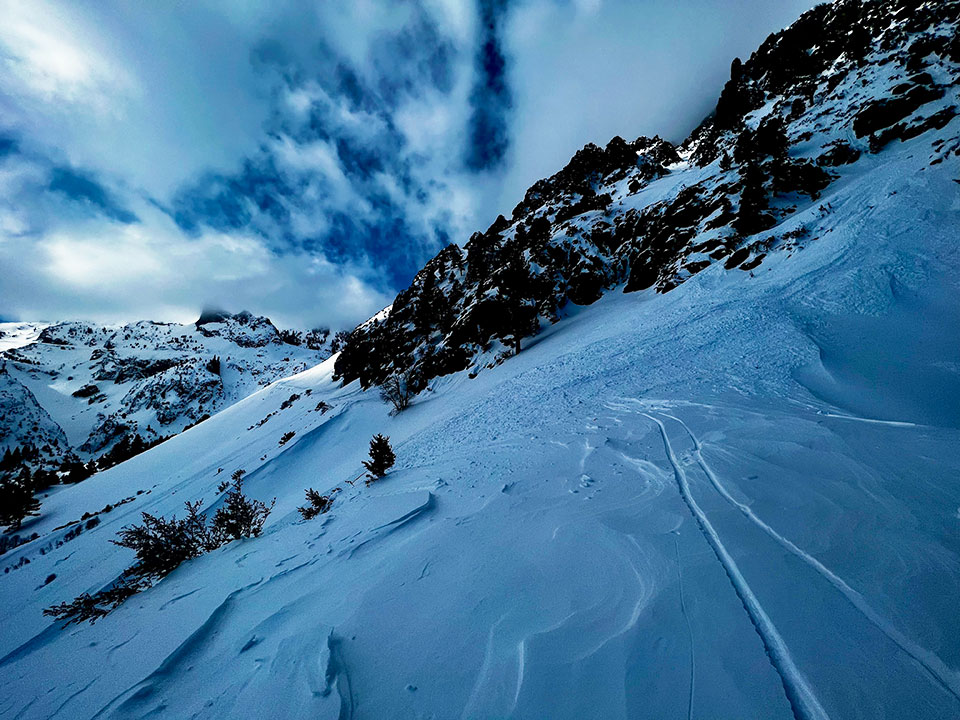New Snow: 8 inches
Settled Snow Depth: 104 inches
High temperature: 45°F (January 21)
Low temperature: -9°F (January 18)
Tuolumne Meadows Living Conditions

Today on our day off, while the winds are exceeding 100 miles per hour at the highest of elevations, we are baking our first loaf of sourdough bread of the season. This is a welcome supplement to the five months’ worth of food we purchased in October before the Tioga Road closed. Unlike the rest of the park’s wildlife that spends a good portion of the summer caching food for the winter, we typically do it in three days. No point in prolonging the agony of pushing overflowing grocery carts only to get our credit cards denied every time despite warning the banks that we will be “making some big purchases.” The line behind us builds up impatiently while one of us is on the phone awaiting approval while the other explains to the cashier that “No, we are not worried about the apocalypse, we are just winter rangers. Oh, you’ve never been to your national park? You should check it out someday. It’s awesome.”
Now that the chest freezer in our shed is dug out and accessible again, we dive into it to put on a few more calories before our first round of snow surveys. Thankfully, the variety and options of dried, jarred and frozen food is much better than it used to be. Ironically, we don’t have time off work to can, jar or dry food of our own. In a year like this, fresh fruit and vegetables are few and far between unless a friend braves a visit. Although we do have some squash, onions, and garlic squirreled away in a dark, dry closet and one battered basil plant that barely survived the ski in. And we just soaked our first sprouts of the season too.
There are no complaints here. Unlike many winter rangers of past and in part thanks to them, we have somewhat reliable electricity along with solar and propane generator backups just in case. In fact, having most modern amenities is what enables us to spend so much time comfortably out of doors. We all are living in the perfect time where we don’t have to waste time washing clothes by hand. Instead, we can utilize that precious time enjoying Nature!
Now we are off to some of the remote, rustic winter snow survey cabins that don’t have running water or electricity. We are keeping our fingers crossed that they are all still standing after this snow load. Stay tuned.
Ski Conditions and Weather
The skies finally cleared over the Sierra Nevada this week. Par for the course, the epic, powder-filled snowstorms of the past three weeks have been replaced by windstorms. There were three notable wind events, the last of which is ongoing as of this writing. An “inside slider” dropped a bonus eight to twelve inches on January 18 and it was accompanied by strong southwest winds. As this storm exited the region, the winds switched direction 180° to blow out of the northeast, and redistributed the new snow to southwest aspects while transforming the once “lee slopes” into “windward slopes.” This typical Sierra Nevada weather certainly keeps winter recreationalists on their toes chasing the best snow conditions while avoiding slopes of high avalanche hazard.
We took the opportunity that the clear weather provided to take a three-day patrol to Tioga Pass and Lee Vining Canyon. Not surprisingly, the parade of Atmospheric Rivers over the past three weeks pretty much buried the National Park Service (NPS) facilities at Tioga Pass. The entrance kiosk was not even visible, and Ferdinand’s Hut only had the chimney sticking up above the snow surface. Many thanks to our pal Cam for his invaluable assistance in its excavation.

The road grade on the east side of Tioga Pass has been transformed into a steep sidehill by avalanche debris and wind sculpted snow. Visitors planning to approach Tuolumne Meadows from Lee Vining should take note. The ski up the Tioga Road is now more of a mountaineering experience than an easy glide on a road grade. Due to this transformation of slope angle, there are areas of high consequence such as near the cliffs of the Green Bridge. And now, travelers will be cutting through the many avalanche paths which formerly were broken by the road.
As for the ski conditions…the winds have taken a toll on the snow surface at all elevations and aspects. Wilderness travelers should expect wind effected snow throughout the central Sierra Nevada. That said, there are areas of soft wind-blown snow and carvable wind board to be had. One has to be creative when looking for the best turning and touring snow conditions at this time.

Avalanche and Snowpack Conditions
Please refer to the Eastern Sierra Avalanche Center (ESAC) and the Bridgeport Avalanche Center for the avalanche advisories for this part of the Sierra Nevada.

Wildlife

Below the Warren Fork a visitor encountered some dazed and confused appearing white-tailed ptarmigan that weren’t very skittish. Perhaps they found it safer on the road than on the adjacent avalanche paths looming above and below them. The California Department of Fish and Wildlife (formerly Game) introduced this species in the early 1970’s for hunting in the alpine zone but ironically most of that land lies within our protected national parks (Beedy & Pandolfino, Birds of the Sierra Nevada, their Natural History and Distribution, 2013).
Questions
The Tuolumne Meadows Ski Hut is open. There is firewood and 8 bunks that are available on a first-come, first-served basis. For those visiting the Tuolumne Ski Hut from the east (only) permits are self-issued at the Ski Hut. For those entering from other areas, please see Yosemite’s website: https://www.nps.gov/yose/planyourvisit/wildpermits.htm (#3: Do I need a wilderness permit during winter?) or you may contact the wilderness office at 209/372-0740. As of this writing, there is electricity but no phone service in Tuolumne Meadows.
Come prepared, and please make good decisions while traveling in the wilderness!
Read through the following two pages before embarking on any day or overnight snow travel within this park:
You may contact us with any additional winter Tuolumne Meadows related questions but response times may vary if we are away on patrol.
Safe travels!
Laura and Rob Pilewski - Tuolumne Meadows winter rangers

